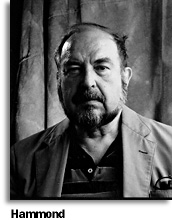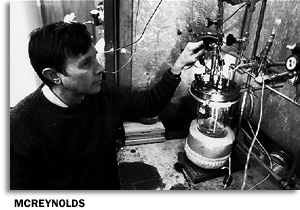 A memorial service will be held in the fall for Mac S. Hammond, 71, a poet and professor emeritus of English, who died of cancer July 9 in his home in Buffalo.
A memorial service will be held in the fall for Mac S. Hammond, 71, a poet and professor emeritus of English, who died of cancer July 9 in his home in Buffalo.
Mac S. Hammond, 71, poet, English professor emeritus
 A memorial service will be held in the fall for Mac S. Hammond, 71, a poet and professor emeritus of English, who died of cancer July 9 in his home in Buffalo.
A memorial service will be held in the fall for Mac S. Hammond, 71, a poet and professor emeritus of English, who died of cancer July 9 in his home in Buffalo.
Hammond began his career at UB in 1963, part of a talented, avant-garde group of writers and teachers who came to the university to create an English department that soon came to be regarded as one of America's brightest and most progressive.
Hammond became a full professor in 1969 and was active in the Faculty Senate, serving as secretary in the late 1960s and early 1970s. He was secretary and coordinator of the Senate's Collegium on Education Innovation in 1974-75. He became a professor emeritus in 1993.
From 1968 to 1971, Hammond was master of Cassirer College, which began as College E, one of UB's experimental colleges offering an alternative to the traditional educational experience. Hammond wrote of the college, "Living and studying in such a college should complement a student's specialization elsewhere in the university," noting that the student "should emerge with increased powers of generalization, a sense of the wholeness of existence, and a living understanding of the virtues of tolerance and compassion."
From 1979 to 1983, Hammond was director of UB's graduate program in creative writing.
The author of four volumes of poetry�"The Horse Opera and Other Poems" (1966); "Cold Turkey" (1969); "Six Dutch Hearts" (1978), and "Mappamundi, New and Selected Poems" (1989)�Hammond also wrote for magazines such as the Paris Review, Poetry and Choice. He was invited to the White House in 1980 by President Jimmy Carter for a program honoring 200 American poets.
Carl Dennis, a poet and colleague on the UB English faculty, noted in The Buffalo News that Hammond's poetry was "a mixture of romantic hoping and very down-to-earth concreteness...He was very much his own man. He wasn't part of any school."
Hammond, a co-founder of the Student Faculty Film Club at UB, also made audio and video recordings, including a three-track tape of "The Holidays," a suite of poems for simultaneous voices made at UB's Electronic Music Library in 1968. In recent years, he combined video art and poetry in videos shown in Buffalo, Chicago and San Francisco. The co-founder of the Nickel City Poetry/Video Association, Hammond was president of Squeaky Wheel, a non-profit organization devoted to video arts, until early this year.
Hammond served in the Navy V-12 program while studying at the University of North Carolina and received his bachelor's degree from the University of the South in Serwanee, Tenn. He received his master's and doctoral degrees from Harvard University.
Walter P. Koprucki, 85, clinical professor
A Mass of Christian Burial was held July 14 at St. Benedict's Church in Amherst for Walter P. Koprucki, a retired clinical professor in the School of Medicine and Biomedical Sciences. Koprucki died July 11 in Sisters Hospital after a lengthy illness.
He graduated from UB medical school in 1936 and began a private practice on Fillmore Avenue the next year, continuing until his retirement in 1980. From 1971 to 1977, he served as an assistant clinical professor at the UB medical school, and from 1977 to 1983, was a fulltime clinical professor at UB. He also served as a clinical faculty member at Buffalo State College from 1976 to 1977.
Koprucki was school physician for the Erie County Health Department from 1944-1976 and was medical examiner for the Federal Aviation Administration from 1961 to 1980. A veteran of World War II, he served as a member of the Greater Buffalo International Airport Disaster team.
James H. McReynolds, 54, biophysicist, professor, lab director
 James H. McReynolds, 54, a biophysicist and UB faculty member since 1977, died July 6 in a rock- climbing accident in Mount Nemo Conservation Area in Burlington, Ont.
James H. McReynolds, 54, a biophysicist and UB faculty member since 1977, died July 6 in a rock- climbing accident in Mount Nemo Conservation Area in Burlington, Ont.
According to regional police at Burlington, McReynolds, an experienced climber, was making a first ascent on the south rock face of Mount Nemo when the rock face gave way, causing him to fall 50 feet and the rock slab to fall on top of him. Despite rescue efforts by police, firefighters, air-ambulance personnel and a friend with whom he was climbing, McReynolds died at the scene.
McReynolds was an associate professor in the biophysics and physiology department of the School of Medicine and Biomedical Sciences. He was director of the mass spectrometry laboratory and held an appointment in the Department of Pharmacology and Toxicology.
"Dr. McReynolds was a very important member of the biophysics department," Richard Zobel, vice chairman of the medical school's biophysics and physiology department, told The Buffalo News. "He was director of undergraduate studies in the department and was the major person responsible for the undergraduate program." Zobel noted that McReynolds was conscientious and well-liked by his students, and interested in undergraduate, graduate and medical- student education. He was also responsible for training students in mass spectrometry.
McReynolds received a bachelor's degree in physics from Rice University in Houston and a Ph.D. in biophysics from the University of Houston. Before coming to UB in 1977, he spent five years as a researcher at the Stanford Research Institute in Palo Alto, Calif.
He was immediate past president of the local chapter of the Adiron-dack Mountain Club and was an active member of the Lumber City Rock Gym in North Tonawanda. For many years, he served as a leader for Boy Scout Troop 991 at North Presbyterian Church in Amherst.
A memorial service was held July 19 in University Presbyterian Church, with graveside services in Conroe, Texas.
William E. Mosher, 88, health commissioner, clinical professor<p> William E. Mosher, 88, who was Erie County Health commissioner from 1959 to 1976 and had served as an associate clinical professor at UB, died July 13 in Buffalo General Hospital after suffering a fall in Toronto.
Mosher was an associate clinical professor in preventive medicine in the UB medical school and assistant professor in the School of Nursing. His published articles on child health included a wide range of topics from hearing loss to neuromuscular and heart disease.
He served as Erie County's chief health officer during years when government had to address water pollution in Lake Erie and contamination of area waterways by municipal sewage treatment plants. The department, under his leadership, expanded work on treatment and prevention of tuberculosis and attracted more than $5 million in federal grants.
He established community health centers, programs for family planning, glaucoma testing, lead poisoning, rodent control and tuberculosis testing of schoolchildren and welfare recipients. As recently as last month, he was consulted about Amherst's mosquito control program.
He was a diplomate of the American Board of Preventive Medicine and Public Health and was a fellow and past secretary of the health officers' section of the American Public Health Association as well as a past president of the State Public Healh Association.
Named an outstanding citizen by The Buffalo News in 1960 and honored by the National Conference of Christians and Jews, he served on boards of the American Cancer Society, Empire State Health Council and nine other health organizations. In 1972, he received the Hermann M. Biggs Award from the State Public Health Association.
A graduate of Hamilton College and the Syracuse University Medical School, he held a master's degree from the Harvard School of Public Health.
Robert E. Pantera, 76, dental school professor
A Mass of Christian burial was held July 11 in St. Aloysius Gonzaga Catholic Church, Cheektowaga, for Robert E. Pantera, 76, a faculty member in the School of Dental Medicine from 1955 until his retirement in 1989. Pantera died July 8 in St. Joseph Hospital, Cheektowaga, after a brief illness.
Pantera was a clinical instructor in the Fixed Prosthodontics Department from 1955 to 1961 and later became an assistant professor and acting chairman of the department.
Pantera, who studied engineering at the University of Michigan, served in the U.S. Army during World War II. On his return from service, he was persuaded by his brothers, one a dentist, the other a dental student, to attend the UB dental school, where he graduated in 1955.
He was a member of the 8th District, Erie County and New York State Dental societies and the American Dental Association.